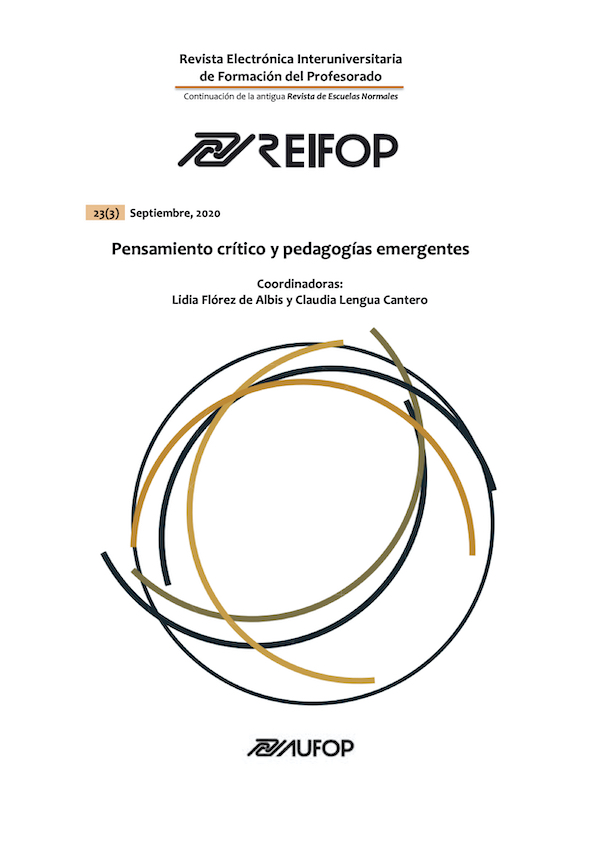Evidence of the development of higher order thinking in university professors, from test formulated according to SOLO taxonomy
Abstract
This paper aims to show the presence of higher order thinking, in university teachers through the application of a diagnostic instrument focus on competencies and structured by using the SOLO taxonomy (Structure of Observed Learning Outcome) and the item response theory (IRT), proposed in the Rasch model. The instrument was developed by teachers from CECAR, within the framework of a process of strengthening educational quality called “Teaching to Think”. The results demonstrate the effectiveness of the instrument to determine a direct relationship between the response ability against the item, the identification of training levels according to SOLO taxonomy and the presence of higher order thinking. However, the diagnosis was not very satisfactory, due to only 4.3% y el 6.6% of the teachers answered the questions of the extended abstract level, about the critical reading skills and quantitative reasoning respectively.
Downloads
-
Abstract2082
-
PDF (Español (España))1819
References
Anderson, W. l. y Krathwohl, D. R., (Eds.), Airasian, P.W., Cruikshank, K.A., Mayer, R.E., Pintrich, P.R., … y Wittrock, M.C. (2001). Una taxonomía para el aprendizaje, enseñanza y evaluación: una revisión de la taxonomía de Bloom de objetivos educativos. Boston: Allyn y Bacon.
Anat, Z. (2006). El pensamiento de orden superior en las clases de ciencias: objetivos, medios y resultados de investigación. Enseñanza de las Ciencias: revista de investigación y experiencias didácticas. 24(2), pp. 157-172. Recuperado de https://www.raco.cat/index.php/Ensenanza/article/view/75823/96327
Baker, F. (2001). The basic of item response theory. United States of America: ERIC Clearinghouse on Assessment and Evaluation.
Biggs, J. B., & Collis, K. F. (1982). Evaluating the quality of learning: The SOLO taxonomy (Structure of the Observed Learning Outcome). New York: Academic Press.
Biggs, J. B. (2005). Calidad del aprendizaje universitario. Madrid: Narcea S.A.
Bloom, B. S. (1956). Taxonomy of educational objectives: The classification of educational goals, handbook 1 cognitive domain. New York: David McKay Co. Inc
Bogoya, D., Barragán S., Contento, M. y Ocaña, A. (2014). Calibración de instrumentos de evaluación – clasificación en matemáticas en la Universidad Jorge Tadeo Lozano. Revista Complutense de Educación. 25(2). 501-519. Recuperado de http://dx.doi.org/10.5209/rev_RCED.2014.v25.n2.41931
Costa, A., & Kallick B. (2005) Habits of mind. A curriculum for Community High School of Vermont Students. Edited by Arthur L Costa y Bena kallick. Recuperado de https://www.chsvt.org/wdp/Habits_of_Mind_Curriculum_VT_WDP.pdf
Chun, T y Abdullah, M (2019). The teaching of higher order thinking skills (HOTS) in Malaysian schools: Policy and practices. Malaysian Online Journal of Educational Management. , 7(3), 1 – 18.
Fernández, A. y Pinzón, G. (2017). ¿De qué debemos desprendernos para cambiar la educación? En A. Forés y E. Subias, Pedagogías emergentes 14 preguntas para el debate (pp. 41-56). Barcelona: Octaedro.
Gardner, H (1995). Inteligencias múltiples. La teoría en la práctica. Barcelona-España: Paidós.
Gardner, H. (2016). El Proyecto Zero de Harvard: una historia personal. Escuela de graduados en Educación de la Universidad de Harvard. Uaricha, 13 (30), 26-52.
Hattie, J.A.C., & Brown, G.T.L. (2004). Cognitive processes in asTTle: The SOLO taxonomy. asTTle Technical Report #43, University of Auckland/Ministry of Education.
Instituto Colombiano para el Fomento de la Educación Superior. (2019). Informe de resultados Saber Pro. Recuperado de https://www2.icfes.gov.co/resultados-saber-pro
King, F.J., Goodson, L., & Rohani, F. (1998). Higher order thinking skills: Definition, teaching strategies and assessment. Publication of the Educational Service Program. Recuperado de https://informationtips.files.wordpress.com/2016/02/higher-order-thinking-skills_.pdf
Lewis, A., & Smith, D. (1993). Defining higher order thinking: Theory into practice, 32 (3), 131-137, doi: 10.1080/00405849309543588. Recuperado de https://www.tandfonline.com/doi/abs/10.1080/00405849309543588
Luria, A. (2000). Las funciones corticales superiores del hombre. México D.F.: Ediciones Fontamara. México. D.F.
Perkins, D. (1995) La escuela inteligente. Barcelona: Gedisa.
Piaget, J. (2009). La psicología de la inteligencia. Barcelona: Biblioteca de Bolsillo.
Resnick, L. (1987). Education and learning to think. Washington D. C.: National Academy Press.
Seif, A. (2019). Integration of higher order thinking skills into the Arab education system in Israel: A general perspective. Italian Journal of Sociology of Education, 11(3), 304-346.
Shardakov, M. (1985). Desarrollo del pensamiento en el escolar. México D.F.: Grijalbo.
Swartz, R., Costa, A., Beyer, B., Reagan, R. y Kallick, B. (2008). El aprendizaje basado en el pensamiento. Cómo desarrollar en los alumnos las competencias del siglo XXI. Vitoria, España: Ediciones SM.
Unigarro, M. (2018). Creación del sistema institucional de evaluación de competencias de la Universidad Cooperativa de Colombia. En S. Castillo, C. Roldan, D. González, O. Rodríguez y C. Ruano. Evaluación de aula, evaluación estandarizada y emergencia de sistemas de evaluación de aprendizajes (pp. 299-316). Cali: Editorial Bonaventura – Programa Editorial Universidad Autónoma de Occidente.
Vigotsky, L. (1978). El desarrollo de los procesos psicológicos superiores. Barcelona: Grijalbo.
Vigotsky, L. (2000). Obras escogidas, III. Madrid: Visor S.A.
Los artículos que se publican en esta revista están sujetos a los siguientes términos:
1. El Departamento de Métodos de Investigación y Diagnóstico en Educación de la Universidad de Murcia (España), junto con el Servicio de Publicaciones de la Universitdad de Murcia (Editum) son los editores de la revista REIFOP y conserva los derechos patrimoniales (copyright) de los artículos publicados, permitiendo la reutilización de las mismos bajo la licencia de uso indicada en el punto 2.
2. Las obras se publican en la edición electrónica de la revista bajo una licencia Creative Commons Reconocimiento-NoComercial-SinObraDerivada 3.0 España (texto legal). Se pueden copiar, usar, difundir, transmitir y exponer públicamente, siempre que: i) se cite la autoría y la fuente original de su publicación (revista, editores y URL de la obra); ii) no se usen para fines comerciales; iii) se mencione la existencia y especificaciones de esta licencia de uso.
3. Condiciones de auto-archivo. Se permite y se anima a los autores a difundir electrónicamente las versiones pre-print (versión antes de ser evaluada) y/o post-print (versión evaluada y aceptada para su publicación) de sus obras antes de su publicación, ya que favorece su circulación y difusión más temprana y con ello un posible aumento en su citación y alcance entre la comunidad académica. Color RoMEO: verde.















